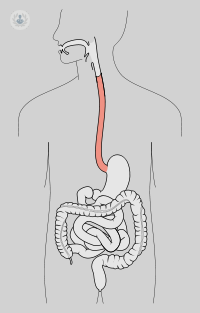Gastroesophageal reflux: Causes, treatment and recommendations
Written by:Gastroesophageal Reflux occurs when stomach acid up into the esophagus and generate stinging or burning in the throat. The causes may be different but timely diagnosis is essential to avoid future complications.

Gastroesophageal reflux (GER), as experts say in General Surgery , is the disorder caused by the passage of stomach contents into the esophagus. The esophagus is a tube that connects the mouth to the stomach through the chest from top to bottom, and therefore adapted to contain food and saliva, but not corrosive gastric juices. These acids, rising into the esophagus can cause a burning sensation in the chest or fire can irritate the throat and cause hoarseness and bad breath, and can even move to the respiratory system and cause coughing or laryngitis. Another serious consequence of GERD, when it is maintained over time, it may cause a special type of esophagitis called Barrett's esophagus, which can lead to esophageal cancer.
Causes of Gastroesophageal Reflux
Everyone reflux greater or lesser extent, but in some cases is excessive and begins to cause problems more or less important. The fundamental cause of reflux is excessive loss of strength in the muscle that makes valve to prevent the return of stomach contents into the esophagus. A call this valve the lower esophageal sphincter (LES) and can be weakened for many reasons: first, it is a muscle and, like any other, in some individuals is stronger than in other. But in addition, some diseases can further weaken the sphincter, including hiatal hernia. Moreover, certain drinks and foods such as alcohol, garlic, tomato, fats and nuts also favor the opening of the sphincter and therefore reflux. Finally, other factors that increase reflux are those involving increased pressure on the sphincter: obesity, abdominal muscle hypertrophy, large meals, the position upside down or lying or using tight clothing.
Diagnosis Gastroesophageal Reflux
The rationale for the diagnosis of GERD is called pH monitoring test (pronounced pe-achi-metry) and involves the introduction of a small tubes through the nose to measure the acidity in different parts of the esophagus over 24 hours. Esophageal manometry is performed in conjunction with pH monitoring and reporting on the strength of the LES and esophageal motility. Gastroscopy and upper GI barium to diagnose esophagitis or Barrett's esophagus and hiatal hernia, if any.
Gastroesophageal Reflux Treatment
Depending on the severity of symptoms or inflammation of the esophagus, we may use alone or in combination of these three forms of treatment:
1) dietary treatment, to avoid situations that encourage reflux
2) drug treatment: To reduce the acidity of gastric juice
3) surgery: laparoscopic valve system that replaces the effect of ERA and provides the ultimate solution is created.
Recommendations to the Gastroesophageal Reflux
Therefore, the 7 steps that we can recommend if you have heartburn or reflux cough are:1. Maintain a healthy weight and avoid tight clothing2. Elevate the head of the bed (for example, putting a fat book on the legs of the head of the mattress3. Do not lie down after eating food (pass a couple of hours)4. No smoking. Carcinogenic effect increases the risk of GERD5. Avoid alcohol and foods that cause reflux (garlic, tomatoes, nuts, fatty foods), especially at dinner6. Avoid heavy meals. Better several small meals a generous amount.7. yourself in the hands of a specialist. There are effective remedies for this problem and not deal with, in addition to supporting burning symptoms, cough or halitosis long, can lead to very serious consequences.



